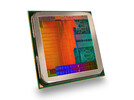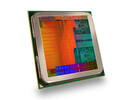Intel Core i7-7567U vs AMD A8-7100 vs AMD A8 Pro-7150B
Intel Core i7-7567U
► remove from comparison
The Intel Core i7-7567U is a fast dual-core SoC for notebooks based on the Kaby Lake architecture and was announced in January 2017. The CPU has two processor cores clocked at 3.5-4 GHz (two cores up to 3.9 GHz). The processor can execute up to four threads simultaneously thanks to Hyper Threading. It is also equipped with an Intel Iris Plus Graphics 650 GPU with 64 MB eDRAM, a dual-channel memory controller (DDR4) as well as VP9 and H.265 video decoding as well as encoding. The chip is still manufactured in a 14nm process with FinFET transistors.
Compared to the Core i7-7560, the 7567U has a higher TDP of 28 vs. 15 Watts as well as higher clocks.
Architecture
Intel basically uses the same micro architecture compared to Skylake, so the per-MHz performance does not differ. The manufacturer only reworked the Speed Shift technology for faster dynamic adjustments of voltages and clocks, and the improved 14nm process allows much higher frequencies combined with better efficiency than before.
Performance
Thanks to the high clocks pf up to 4 GHz and 64 MB eDRAM (can also be used as L4 cache by the CPU), the Core i7-7567U is the fastest dual-core for notebooks in the beginning of 2017. It competes with lower clocked quad-core models and can convince by the excellent single-thread performance. Some games might require a real quad-core though and could not run perfectly on the dual-core, despite Hyper Threading.
Graphics
The integrated Intel Iris Plus 650 Graphics is the GT3e model of the Kaby Lake GPU (Intel Gen. 9.5). It has 48 Execution Units running at 300-1100 MHz and the performance is comparable to a GeForce 920MX thanks to fast eDRAM cache. However, there aren't any significant improvements compared to the old Iris Pro 550, so modern games can often not be played smoothly or only at the lowest or medium settings, respectively.
Contrary to Skylake, Kaby lake now also supports H.265/HEVC Main 10 with a 10-bit color depth as well as Google's VP9 codec. The dual-core Kaby Lake processors announced in January should also support HDCP 2.2.
Power Consumption
The chip is manufactured in an improved 14nm process with FinFET transistors, which improves the efficiency even further. Intel specifies the TDP with 28 Watts, which can be reduced to 23 Watts (cTDP Down) depending on the usage scenario. The TDP is pretty high compared to the common 15-Watt TDP for dual-core processors, but allows a better utilization of CPU and GPU Turbo.
AMD A8-7100
► remove from comparison
The AMD A8-7100 is a power efficient ULV (Ultra Low Voltage) quad-core processor based on the Kaveri architecture. It was revealed in June 2014 for notebooks and is manufactured by GlobalFoundries using a 28 nm SHP process. In addition to having two CPU modules for a total of four integer cores clocked at 1.8 - 3.0 GHz, the AMD chip also integrates a Radeon R5 GPU clocked at up to 514 MHz with 256 GCN shaders and a dual-channel DDR3-1600 memory controller.
Architecture
Kaveri is the successor to the 2013 Richland architecture (e.g. A10-5750M). The revised CPU cores, codenamed Steamroller, represent the third generation of the module-based Bulldozer design. A number of major changes include modified decoders (now one per integer core), optimized branch prediction, and increased L1 I-cache from 64 KB to 96 KB per module. These revisions boost the performance per clock slightly over a similarly clocked Richland APU. For more details about the AMD Kaveri architecture, see our detailed analysis here:
Analysis of the AMD Kaveri Notebook Platform
Performance
According to our benchmarks, the A8-7100 offers a CPU performance similar to the Haswell-based Intel Core i3-4010U. While the Core i3 wins in single-thread benchmarks, the A8-7100 takes the lead in some multi-thread tests. Overall, the A8-7100 will be sufficient for all daily workloads (Office, Internet browsing, multimedia) as well as light multitasking.
Graphics
The Radeon R5 (Kaveri) GPU of the A8-7100 features a core clock of up to 514 MHz and 256 shader units. Since the GPU is based on AMD's GCN 1.1 architecture, both DirectX 11.2 "Tier 2" and Mantle are supported. Furthermore, the GPU can be used for general purpose computing in various applications, such as Adobe Photoshop via the OpenCL API.
In terms of 3D performance, the GPU is roughly as fast as a dedicated GeForce 710M and can handle many current games at low settings and (W)XGA resolution (as of 2014).
Power Consumption
The power consumption of the entire APU is rated at 19 Watts, which is somewhat above the Haswell ULV CPUs from Intel (15 W including chipset). Nevertheless, the A8-7100 is suited for 12 - 13-inch notebooks or larger.
AMD A8 Pro-7150B
► remove from comparison
The AMD A8 Pro-7150B is a power efficient ULV (Ultra Low Voltage) quad-core processor based on the Kaveri architecture. It was revealed in June 2014 for notebooks and is manufactured by GlobalFoundries using a 28 nm SHP process. In addition to having two CPU modules for a total of four integer cores clocked at 1.9 - 3.2 GHz, the AMD chip also integrates a Radeon R5 GPU clocked at up to 533 MHz with 384 GCN shaders and a dual-channel DDR3-1600 memory controller.
Technically, the 7150B is almost identical with the consumer model A10-7300. However, AMD guarantees an especially high stability and durability for the business-oriented Pro-Series.
Architecture
Kaveri is the successor to the 2013 Richland architecture (e.g. A10-5750M). The revised CPU cores, codenamed Steamroller, represent the third generation of the module-based Bulldozer design. A number of major changes include modified decoders (now one per integer core), optimized branch prediction, and increased L1 I-cache from 64 KB to 96 KB per module. These revisions boost the performance per clock slightly over a similarly clocked Richland APU. For more details about the AMD Kaveri architecture, see our detailed analysis here:
Analysis of the AMD Kaveri Notebook Platform
Performance
According to the clock rates, the A8 Pro-7150B should offer a CPU performance level similar to the Haswell-based Intel Core i3-4010U. Overall, the 7150B will be sufficient for all daily workloads (Office, Internet browsing, multimedia) as well as light multitasking. Detailed benchmark can be found on the cpu page of the A10-7300 APU.
Graphics
The Radeon R5 (Kaveri) GPU of the A8 Pro-7150B features a core clock of up to 533 MHz and 384 shader units. Since the GPU is based on AMD's GCN 1.1 architecture, both DirectX 11.2 "Tier 2" and Mantle are supported. Furthermore, the GPU can be used for general purpose computing in various applications, such as Adobe Photoshop via the OpenCL API.
In terms of 3D performance, the GPU should be roughly as fast as a dedicated GeForce GT 720M and can handle many current games at low or medium settings at (W)XGA resolution.
Power Consumption
The power consumption of the entire APU is rated at 19 Watts, which is somewhat above the Haswell ULV CPUs from Intel (15 W including chipset). Nevertheless, the A8 Pro-7150B is suited for 12 - 13-inch notebooks or larger.
| Model | Intel Core i7-7567U | AMD A8-7100 | AMD A8 Pro-7150B | ||||||||||||||||||||||||||||||||||||||||||||||||||||||||||||||||||||||||||||||||||||||||||||||||||||||||||||||||||||||||||||||||||||||||||||||||||||||||||||||||||||||||||||||||||||||||||||||||||||||||||||||||||||||||||||||||||||||||||||||||||||||||
| Codename | Kaby Lake | Kaveri | Kaveri | ||||||||||||||||||||||||||||||||||||||||||||||||||||||||||||||||||||||||||||||||||||||||||||||||||||||||||||||||||||||||||||||||||||||||||||||||||||||||||||||||||||||||||||||||||||||||||||||||||||||||||||||||||||||||||||||||||||||||||||||||||||||||
| Series | Intel Kaby Lake | AMD Kaveri | AMD Kaveri | ||||||||||||||||||||||||||||||||||||||||||||||||||||||||||||||||||||||||||||||||||||||||||||||||||||||||||||||||||||||||||||||||||||||||||||||||||||||||||||||||||||||||||||||||||||||||||||||||||||||||||||||||||||||||||||||||||||||||||||||||||||||||
| Series: Kaveri Kaveri |
|
|
| ||||||||||||||||||||||||||||||||||||||||||||||||||||||||||||||||||||||||||||||||||||||||||||||||||||||||||||||||||||||||||||||||||||||||||||||||||||||||||||||||||||||||||||||||||||||||||||||||||||||||||||||||||||||||||||||||||||||||||||||||||||||||
| Clock | 3500 - 4000 MHz | 1800 - 3000 MHz | 1900 - 3200 MHz | ||||||||||||||||||||||||||||||||||||||||||||||||||||||||||||||||||||||||||||||||||||||||||||||||||||||||||||||||||||||||||||||||||||||||||||||||||||||||||||||||||||||||||||||||||||||||||||||||||||||||||||||||||||||||||||||||||||||||||||||||||||||||
| L1 Cache | 128 KB | ||||||||||||||||||||||||||||||||||||||||||||||||||||||||||||||||||||||||||||||||||||||||||||||||||||||||||||||||||||||||||||||||||||||||||||||||||||||||||||||||||||||||||||||||||||||||||||||||||||||||||||||||||||||||||||||||||||||||||||||||||||||||||
| L2 Cache | 512 KB | 4 MB | 4 MB | ||||||||||||||||||||||||||||||||||||||||||||||||||||||||||||||||||||||||||||||||||||||||||||||||||||||||||||||||||||||||||||||||||||||||||||||||||||||||||||||||||||||||||||||||||||||||||||||||||||||||||||||||||||||||||||||||||||||||||||||||||||||||
| L3 Cache | 4 MB | ||||||||||||||||||||||||||||||||||||||||||||||||||||||||||||||||||||||||||||||||||||||||||||||||||||||||||||||||||||||||||||||||||||||||||||||||||||||||||||||||||||||||||||||||||||||||||||||||||||||||||||||||||||||||||||||||||||||||||||||||||||||||||
| Cores / Threads | 2 / 4 | 4 / 4 | 4 / 4 | ||||||||||||||||||||||||||||||||||||||||||||||||||||||||||||||||||||||||||||||||||||||||||||||||||||||||||||||||||||||||||||||||||||||||||||||||||||||||||||||||||||||||||||||||||||||||||||||||||||||||||||||||||||||||||||||||||||||||||||||||||||||||
| TDP | 28 Watt | 19 Watt | 19 Watt | ||||||||||||||||||||||||||||||||||||||||||||||||||||||||||||||||||||||||||||||||||||||||||||||||||||||||||||||||||||||||||||||||||||||||||||||||||||||||||||||||||||||||||||||||||||||||||||||||||||||||||||||||||||||||||||||||||||||||||||||||||||||||
| Technology | 14 nm | 28 nm | 28 nm | ||||||||||||||||||||||||||||||||||||||||||||||||||||||||||||||||||||||||||||||||||||||||||||||||||||||||||||||||||||||||||||||||||||||||||||||||||||||||||||||||||||||||||||||||||||||||||||||||||||||||||||||||||||||||||||||||||||||||||||||||||||||||
| max. Temp. | 100 °C | ||||||||||||||||||||||||||||||||||||||||||||||||||||||||||||||||||||||||||||||||||||||||||||||||||||||||||||||||||||||||||||||||||||||||||||||||||||||||||||||||||||||||||||||||||||||||||||||||||||||||||||||||||||||||||||||||||||||||||||||||||||||||||
| Socket | BGA1356 | ||||||||||||||||||||||||||||||||||||||||||||||||||||||||||||||||||||||||||||||||||||||||||||||||||||||||||||||||||||||||||||||||||||||||||||||||||||||||||||||||||||||||||||||||||||||||||||||||||||||||||||||||||||||||||||||||||||||||||||||||||||||||||
| Features | Dual-Channel DDR4 Memory Controller, HyperThreading, AVX, AVX2, Quick Sync, Virtualization, AES-NI | SSE (1, 2, 3, 3S, 4.1, 4.2, 4A), x86-64, AES, AVX, FMA, DDR3-1600 Controller | SSE (1, 2, 3, 3S, 4.1, 4.2, 4A), x86-64, AES, AVX, FMA, DDR3-1600 Controller | ||||||||||||||||||||||||||||||||||||||||||||||||||||||||||||||||||||||||||||||||||||||||||||||||||||||||||||||||||||||||||||||||||||||||||||||||||||||||||||||||||||||||||||||||||||||||||||||||||||||||||||||||||||||||||||||||||||||||||||||||||||||||
| iGPU | Intel Iris Plus Graphics 650 (300 - 1100 MHz) | AMD Radeon R5 (Kaveri) (? - 514 MHz) | AMD Radeon R5 (Kaveri) (? - 533 MHz) | ||||||||||||||||||||||||||||||||||||||||||||||||||||||||||||||||||||||||||||||||||||||||||||||||||||||||||||||||||||||||||||||||||||||||||||||||||||||||||||||||||||||||||||||||||||||||||||||||||||||||||||||||||||||||||||||||||||||||||||||||||||||||
| Architecture | x86 | x86 | x86 | ||||||||||||||||||||||||||||||||||||||||||||||||||||||||||||||||||||||||||||||||||||||||||||||||||||||||||||||||||||||||||||||||||||||||||||||||||||||||||||||||||||||||||||||||||||||||||||||||||||||||||||||||||||||||||||||||||||||||||||||||||||||||
| $415 U.S. | |||||||||||||||||||||||||||||||||||||||||||||||||||||||||||||||||||||||||||||||||||||||||||||||||||||||||||||||||||||||||||||||||||||||||||||||||||||||||||||||||||||||||||||||||||||||||||||||||||||||||||||||||||||||||||||||||||||||||||||||||||||||||||
| Announced | |||||||||||||||||||||||||||||||||||||||||||||||||||||||||||||||||||||||||||||||||||||||||||||||||||||||||||||||||||||||||||||||||||||||||||||||||||||||||||||||||||||||||||||||||||||||||||||||||||||||||||||||||||||||||||||||||||||||||||||||||||||||||||
| Manufacturer | ark.intel.com | www.amd.com | www.amd.com | ||||||||||||||||||||||||||||||||||||||||||||||||||||||||||||||||||||||||||||||||||||||||||||||||||||||||||||||||||||||||||||||||||||||||||||||||||||||||||||||||||||||||||||||||||||||||||||||||||||||||||||||||||||||||||||||||||||||||||||||||||||||||
| Transistors | 2410 Million | 2410 Million | |||||||||||||||||||||||||||||||||||||||||||||||||||||||||||||||||||||||||||||||||||||||||||||||||||||||||||||||||||||||||||||||||||||||||||||||||||||||||||||||||||||||||||||||||||||||||||||||||||||||||||||||||||||||||||||||||||||||||||||||||||||||||
| Die Size | 245 mm2 | 245 mm2 |
Benchmarks
Average Benchmarks Intel Core i7-7567U → 0% n=0
Average Benchmarks AMD A8-7100 → 0% n=0
* Smaller numbers mean a higher performance
1 This benchmark is not used for the average calculation













